We believe in the power of innovation. We understand that it's not just about thinking differently but also about pushing the boundaries of what's possible. Our team of professionals is driven to challenge the status quo and create solutions beyond "good enough". We are dedicated to eliminating the unnecessary and delivering exceptional value to our clients and communities.
Our commitment to staying at the forefront of our industry sets us apart. Our engineers consistently stay updated with the latest research and market technologies in stormwater management. This knowledge fuels our ability to develop creative and effective solutions for even the most complex design issues. Innovation is ingrained in everything we do.
Our team members have established themselves as thought leaders in the industry. They have contributed to reputable peer-reviewed journals and presented at numerous conferences. Their insights and expertise enrich our approach and enable us to provide innovative solutions.
At Gradient, innovation is not just a buzzword - it's a way of thinking that drives us to deliver exceptional results.

RESEARCH PUBLICATIONS (bold author indicates Gradient team member):
- Ekka, S.A., Hendrik Rujner, Günther Leonhardt, Godecke-Tobias Blecken, Maria Viklander, and W.F. Hunt. 2021. Next Generation Swale Design for Stormwater Runoff Treatment: A Comprehensive Approach. Journal of Environmental Management. Vol. 279, 111756, Pages 1-16. https://doi.org/10.1016/j.jenvman.2020.111756
- Hunt, W.F., E.A. Fassman-Beck, S.A. Ekka, K.C. Shaneyfelt, and A. Deletic. 2020. Designing Dry Swales for Stormwater Quality Improvement Using the Aberdeen Equation. Journal of Sustainable Water in the Built Environment, Vol. 6(1):05019004-1:05019004-8. https://ascelibrary.org/doi/abs/10.1061/JSWBAY.0000886
- Strickling, H., DiCarlo, M., Shafiee, M., Berglund, E. 2019. Simulation of containment and wireless emergency alerts within targeted pressure zones for water contamination management. Sustainable Cities and Society, 52. https://doi.org/10.1016/j.scs.2019.101820.
- Strickling, H. L., & Obenour, D. R. 2018. Leveraging spatial and temporal variability to probabilistically characterize nutrient sources and export rates in a developing watershed. Water Resources Research, 54. https://doi.org/10.1029/2017WR022220.
- Winston, R.J., Lauffer, M.S., Narayanaswamy, K., McDaniel, A.H., Lipscomb, B.S., Nice, A. J., and W. F. Hunt. 2015. "Comparing Bridge Deck Runoff and Stormwater Control Measure Quality in North Carolina." Journal of Environmental Engineering. 141(1).
- Adamack A.T., Rose K.A., Breitburg D.L., Nice A. J., Lung W.S. 2012. Simulating the effect of hypoxia on bay anchovy egg and larval mortality using coupled watershed, water quality, and individual-based predation models. Marine Ecology Progress Series 445:141-160.
- Nice, A. J., W.S. Lung, and G.F. Reidel. 2008. Modeling Arsenic in the Patuxent Estuary. Environmental Science and Technology. May 2008.
- Lung, W. S., and A. J. Nice. 2007. A Eutrophication Model for the Patuxent Estuary: Advances in Predictive Capabilities. Journal of Environmental Engineering. September 2007.
- Ekka, S. A., B. E. Haggard, M. D. Matlock, and I. Chaubey. 2006. Dissolved Phosphorus Concentrations and Sediment-Phosphorus Interactions in Effluent Dominated Ozark Streams. Ecological Engineering Vol. 26 (4): 375-391.
- Haggard, B. E., S. A. Ekka, M. D. Matlock, and I. Chaubey. 2004. Phosphate Equilibrium between Stream Sediments and Water: Potential Effect of Chemical Amendments. Transactions of the ASAE Vol. 47 (4): 1113-1118.
ADDING VALUE TO PROJECTS AND CLIENTS
Gradient redefines the way stormwater and site development challenges are tackled. Our innovative approach provides effective solutions and adds significant value to projects, resulting in time and cost savings for our clients. We believe in integrating value engineering throughout every stormwater and site design stage, from conception to construction. Some examples of Gradient's application of innovative practices include:
- Utilizing cloud-based technology for field data collection minimizes errors and reduces time and costs.
- Designing parallel storm drain systems in urban areas to avoid utility conflicts and street closures, resulting in substantial time and cost savings.
- Employing data visualization techniques to effectively communicate project impacts to stakeholders, fostering transparency and understanding.
